Pond and Wet Bed

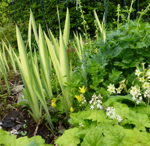
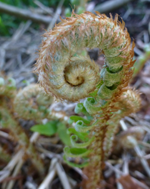
Some ground adjacent to the hedge in the back garden seemed even more claggy and damp than the rest of the garden, perhaps because there was an underlying spring somewhere deep in the clay, so I made a damp bed in this shady East-facing strip for plants with lush foliage such as hostas and Rodgersia podophylla, ferns, Tiarella cordifolia and the handsome sword-like yellow and green leaves of Iris pseudacorus 'Variegata'. The striking celandine 'Brazen Hussy' (from Great Dixter) with its dark purple leaves and golden flowers spreads around happily.
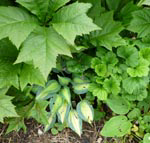
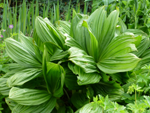
I particularly love my large clump of Veratrum nigrum (Black false hellebore). The magnificent leaves look as if they are pleated, until the snails attack and they turn to lace. Tall spikes of purple-black star-shaped flowers appear in early summer but I grow it for the leaves.
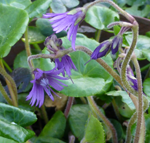
Another very special treasure is Soldanella villosa (Alpine snowbell) with delicately fringed blue flowers.
A pond would attract wildlife and I wanted a marshy bed where I could nurture such treasures as Primula japonica, Fritillaria meleagris (Snakes head fritillary), and Lysichiton camtschatcensis (Asian skunk-cabbage).
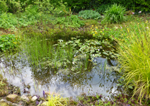
The answer was to dig out a small pond and marsh below my new damp bed. Rather than puddling clay, I used a butyl liner. The liner extends under the ground several feet beyond the upper margin of the pond. This area is backfilled with claggy soil to provide a small marsh abutting the pond, which keeps it damp.
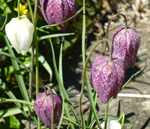
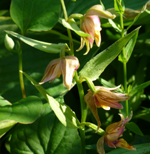
Snakes-head fritillaries are a real joy in the spring. Marsh Helleborine (Epipactis palustris) is a more subtle treat.
Marsh marigolds (double and single), Bog bean (Menyanthes trifoliata), Bowles' Golden Sedge (Carex elata 'Aurea') and the Sensitive Fern (Onoclea sensibilis) have spread around the margins. The pond is home to newts, dragonflies, damsel flies and even a visiting mallard (a brief stay to my relief).
Rain water collected from the roof of the house into water butts is used to top up the pond via a hose pipe running under the lawn. It is only in really dry weather, that we have to resort to tap water.